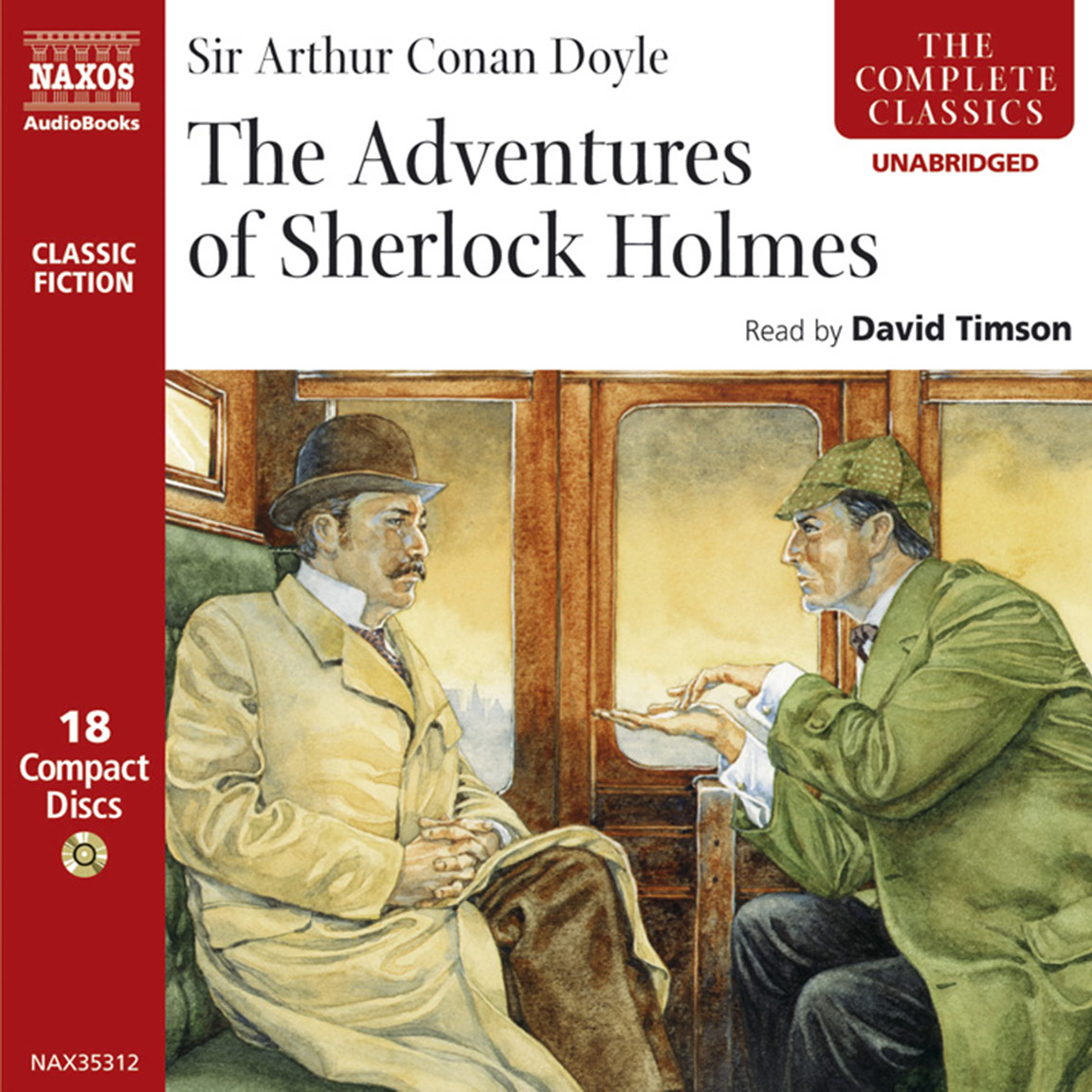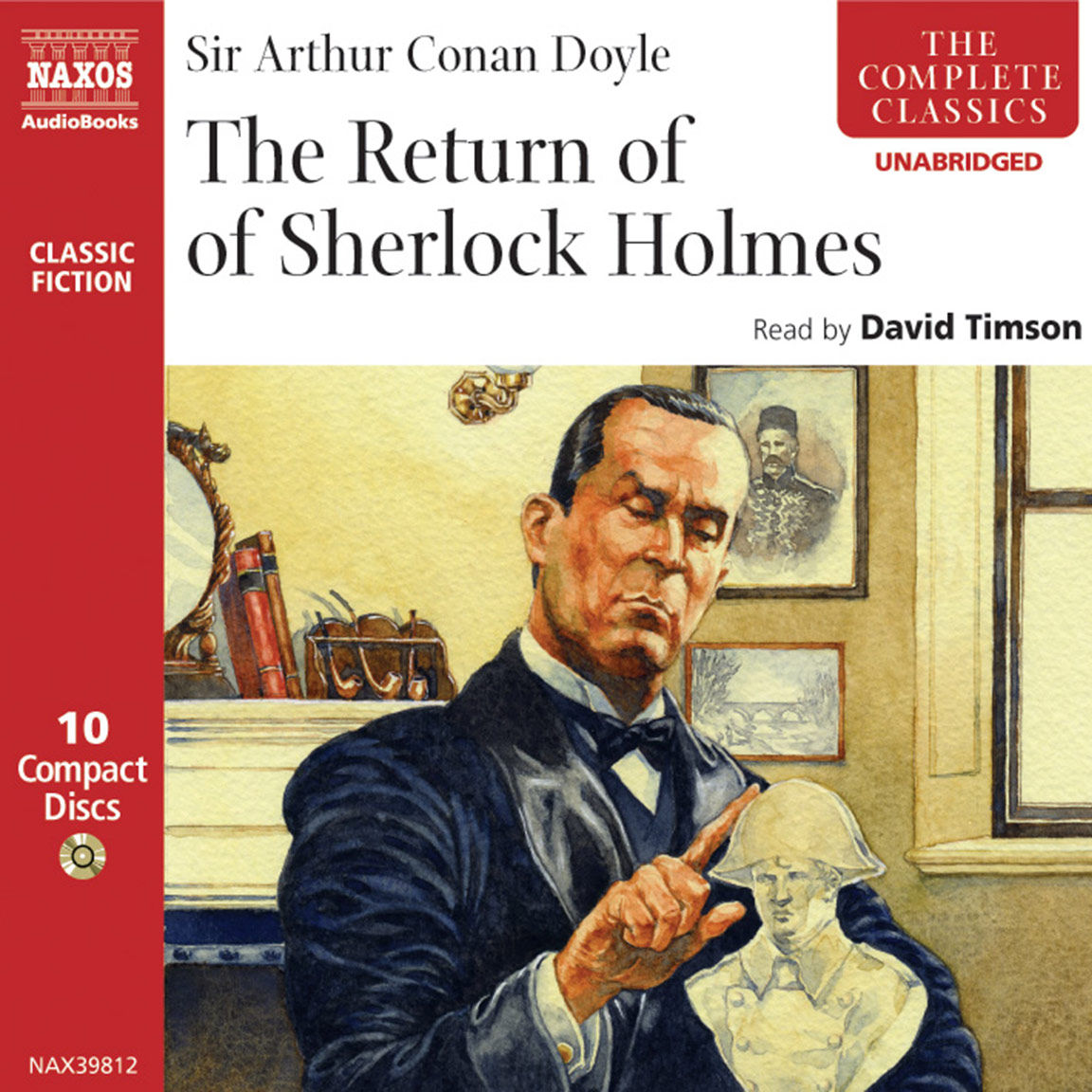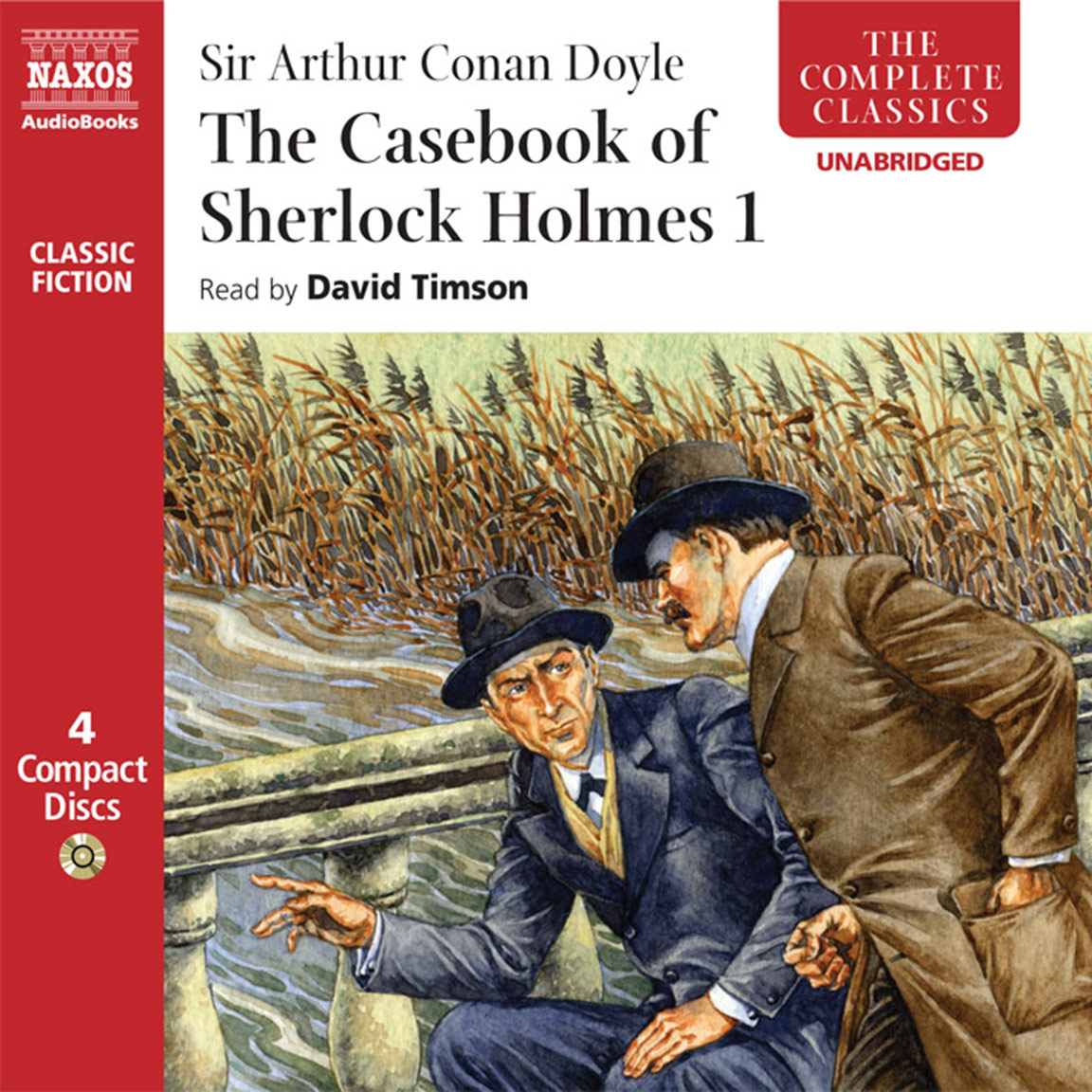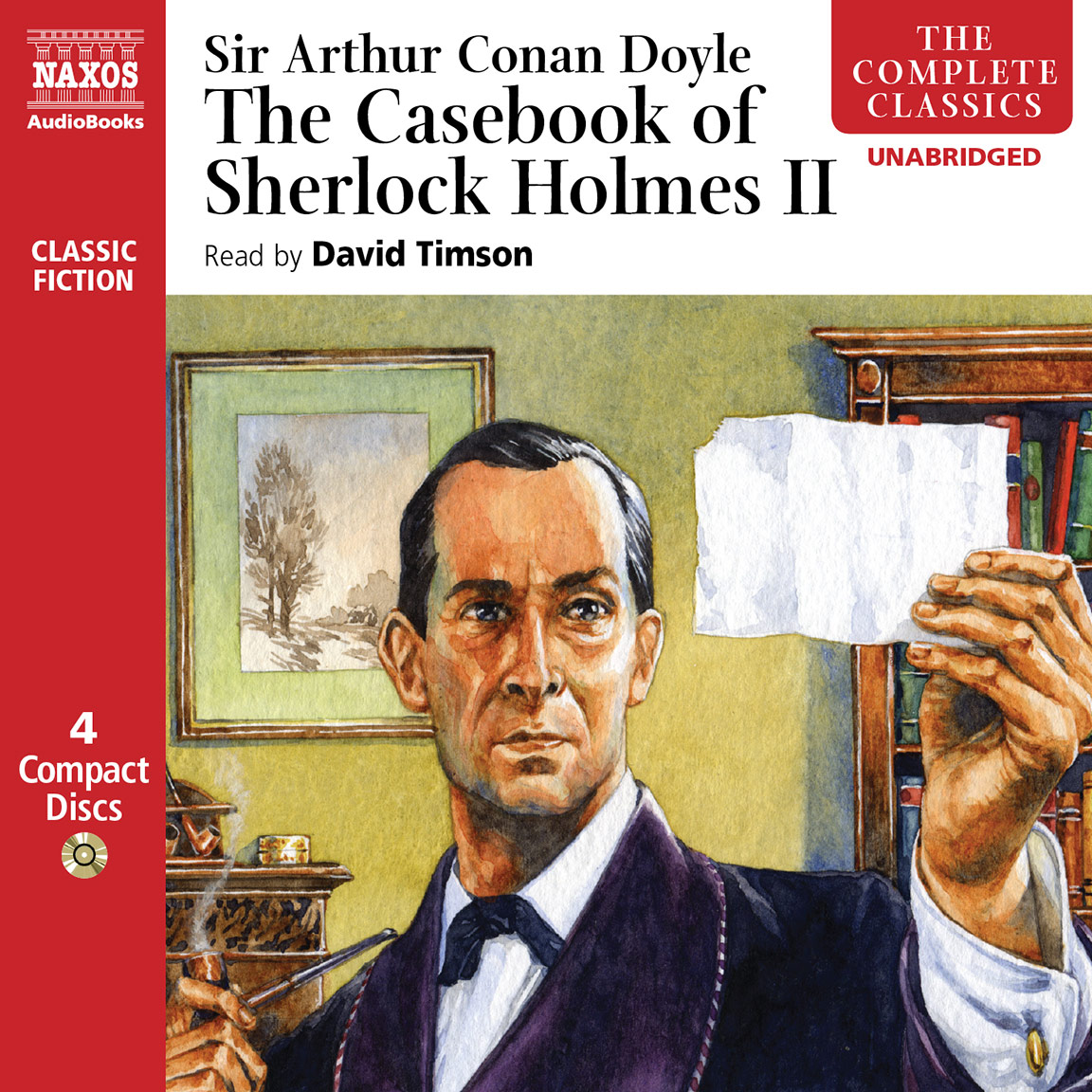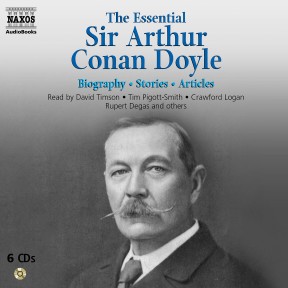
Audio Sample
Sir Arthur Conan Doyle
The Essential Sir Arthur Conan Doyle
Read by David Timson, Glen McCready, Crawford Logan, Tim Pigott-Smith, Carl Rigg, Rupert Degas & Jonathan Oliver
selections
The rich life Sir Arthur Conan Doyle (1859-1930) is featured here: his work as a doctor, his novels and journalistic writings, his support of Spiritualism and his defence of fairies. This is a unique set for the 150th anniversary of his birth. After his early years in medicine, the writing talents of Arthur Conan Doyle took over. Sherlock Holmes and Professor Challenger were among his successes. David Timson, an actor and director who has read the complete Sherlock Holmes collection for Naxos AudioBooks, has compiled this commemorative collection showing the range of Conan Doyle’s life and work. It includes the 2 CD biography by Hesketh Pearson, The Speckled Band, an excerpt from The Lost World and his defence of the Cottingley Fairies.
-
Running Time: 7 h 37 m
More product details
Digital ISBN: 978-962-954-971-8 Cat. no.: NA695512 Download size: 111 MB Produced by: David Timson and Nicolas Soames BISAC: FIC004000 Released: April 2009 -
Listen to this title at Audible.com↗Listen to this title at the Naxos Spoken Word Library↗
Due to copyright, this title is not currently available in your region.
You May Also Enjoy
Reviews
The success of Sherlock Holmes obscured the spectacular range of Conan Doyle’s writings represented here, including Brigadier Gerard and Professor Challenger from his adventure and historical novels, and his serious essays on spiritualism.
Rachel Redford, The Observer
Sherlock Holmes fans will appreciate this examination of the famous detective’s creator, Arthur Conan Doyle (1859–1930). It begins with a biographical sketch of Conan Doyle, a Scot educated in medicine at the University of Edinburgh. Holmes was his most celebrated creation by far, a fact that was more irritating than pleasing to Conan Doyle, whose prolific output included a myriad of short stories and historical novels that he considered more deserving of admiration than the adventures of the clever “consulting detective.” This set includes one Holmes story and a broad sampling of Conan Doyle’s other creations—from a horror story to his impassioned writings on spiritualism and fairies. The audio production is clear and compelling. The narrators, all British, do an excellent job of conveying the drama of Conan Doyle’s well-paced prose.
M.G., AudioFile
Booklet Notes
In seeking the essential ingredients that make up the man who was Sir Arthur Conan Doyle, there is one characteristic that recurs again and again: he loved a good fight. In writing of his earliest years, for instance, in his entertaining autobiography Memories and Adventures, recollections of the ‘scraps’ he got into frequently occur:
‘If there is any truth in the idea of reincarnation…I think some earlier experience of mine must have been as a stark fighter, for it came out strongly in youth, when I rejoiced in battle. We lived for some time in a cul de sac street with a very vivid life of its own and a fierce feud between the small boys who dwelt on either side of it. Finally it was fought out between two champions, I representing the poorer boys who lived in flats and my opponent the richer boys who lived in the opposite villas and had an excellent contest of many rounds, not being strong enough to weaken each other. When I got home after the battle, my mother cried, “Oh Arthur, what a dreadful eye you have got!” To which I replied, “You just go across and look at Eddie Tulloch’s eye!”.’
As he matured, his inclination to fight moved away from the directly physical to the philosophical – fighting for a cause.
In 1912, Conan Doyle gave his support to the actions of the captain of the Titanic, whom he felt had been unjustly blamed for the disaster. George Bernard Shaw had started the skirmish by writing an article in The Daily News and Leader, in which he called the public reaction to the so-called heroism of the captain and crew as nothing but ‘romantic’ rubbish. The captain, Shaw wrote: ‘had lost his ship by deliberately and knowingly steaming into an ice-field at the highest speed he had coal for’. His actions, Shaw claimed, had not been courageous, as the popular press reported. ‘I ask,’ Shaw continued, ‘what is the use of all this ghastly, blasphemous, inhuman, braggartly lying?’
Conan Doyle protested in a spirit of self-righteous anger at this attack on Captain Smith’s courage:
‘How a man could write with such looseness and levity of such an event at such a time passes all comprehension…His next paragraph is devoted to the attempt to besmirch the conduct of Captain Smith… the false suggestion being that the sympathy shown by the public for Captain Smith took the shape of condoning Captain Smith’s navigation. Now everyone – including Mr. Bernard Shaw – knows perfectly well that no defence has ever been made of the risk which was run, and that the sympathy was at the spectacle of an old and honoured sailor who has made one terrible mistake, and who deliberately gave his life in reparation, discarding his lifebelt, working to the last for those whom he had unwillingly injured, and finally swimming with a child to a boat into which he himself refused to enter.’
Shaw replied at length in print: ‘Sentimental idiots, with a break in the voice, tell me that “he went down to the depths”: I tell them, with the impatient contempt they deserve, that so did the cat.’
Shaw may have been a realist in his reactions, but the public mood was for the romantic view of Conan Doyle.
He always had sympathy for the underdog, and in taking their part, would often end up with a bloody nose himself. In the cases of George Edalji and Oscar Slater, it is unlikely the public would have noticed the unjust outcome of their respective trials if Conan Doyle had not exposed the flaws in the evidence against them. George Edalji had been convicted in 1906 of maiming horses in Staffordshire. Conan Doyle, employing his fictional sleuth’s approach, looked at the evidence and proved Edalji’s innocence, though the real perpetrator of the crime was never found. Oscar Slater was wrongly accused of murder and spent eighteen years of a life sentence in prison before Conan Doyle exposed the gross incompetence of the police in the case and facilitated his release. Conan Doyle felt that, in both cases, racism had played a part – Edalji being a Parsee and Slater a Jew.
The outcome of these interventions proved uncertain. He was rewarded with ingratitude from Oscar Slater, and from Edalji, bewilderment at all the attention.
In the Boer War, Conan Doyle longed to fight with the British Army, but his age – he was over 40 – excluded him and he had to be content to take up his pen rather than his sword, and attack the accusations of British cruelty against their Boer prisoners.
In his fiction, too, Conan Doyle is at his most vivid when describing conflict. His historical novel The White Company, which he considered his greatest work, is full of scenes of medieval aggression. There is hand-to-hand combat, jousting, sea-battles, castle sieges and the final conflict between the White Company (an elite band of mercenaries), and the full might of the Spanish forces (an extract from which is included on CD 5).
The fascination with fighting continued in Rodney Stone in which he explores the world of eighteenth-century bare-knuckle fighting, the forerunner of the modern boxing match.
But there was one fight that Conan Doyle would never win, though he refused to admit defeat until almost at the end of his life: Mr Sherlock Holmes was to prove more than a match for his creator. Conan Doyle had quickly grown tired of his most famous creation and had attempted to kill him off after only twelve stories. The public, however, would not allow it, and the clamour to revive Holmes was too compelling for the pragmatic Conan Doyle to resist. So Sherlock Holmes was re-born from the depths of the Reichenbach Falls where Conan Doyle had left him in his short story The Final Problem, believing such a violent end would mean it was the last he would ever have to do with him. Why did the author fight so hard to rid himself of his most famous (and most lucrative) creation? Had the Holmes stories become too easy for his literary skills? Did Conan Doyle feel he constantly needed to challenge himself as a writer? Was he experiencing an internal battle with which he could not come to terms? Conan Doyle called himself ‘the man in the street’, but he was more complex than that, and in his poem The Inner Room (on CD 6) – perhaps the most intimate confession we have from him – he reveals the many aspects of Conan Doyle that made the man.
By 1927, when he wrote the final collection of Sherlock Holmes stories, he had thrown in the towel and conceded defeat, though not without humour: ‘I fear that Mr. Sherlock Holmes may become like one of those popular tenors who, having outlived their time, are still tempted to make repeated farewell bows to their indulgent audiences…’
By this stage of his life, however, Conan Doyle had other battles to concern him. He had embarked on the greatest fight of his life – to convert the world to spiritualism (see CD 6).
He was to endure much hostility from the public in this conflict. Bloodied, but unbowed, he soldiered on, even surviving the howls of ridicule that ensued when he declared he believed in fairies (CD 6).
In 1929, Conan Doyle was given the opportunity to spread the word about psychic phenomena to a potentially vast audience. The film company Fox-Case Movietone invited him to speak on the subject in a short, eleven-minute film. ‘Talking pictures’ were a new phenomenon, but Conan Doyle responded enthusiastically. After declaring: ‘I’ve got to speak one or two words, just to try my voice I understand…’, he plunged into a seemingly spontaneous and energetic speech, which included a declaration of his complete belief and faith in spiritualism (an extract can be heard on CD 6). But the first part of the speech, no doubt at the insistence of the film company, consists of a frank account of the creation of his masterpiece, Sherlock Holmes (an extract is on CD 3).
A year later, in July 1930, Conan Doyle died, aged 71. The epitaph on his grave is fitting for an old warrior who loved a fight: ‘STEEL TRUE – BLADE STRAIGHT’.
A Brief Biography of Sir Arthur Conan Doyle
Arthur Conan Doyle was born in 1859 in Edinburgh, a city soaked in history, which gave him a strong sense of the past which he never lost. He was educated at Stonyhurst School, where he excelled at sport, a lifelong interest, and developed a passion for reading. The ideals he read about in his history books influenced him all his life.
He trained to be a doctor at Edinburgh University, and before qualifying signed on as ship’s surgeon aboard a whaler. The hardened crew’s tough stories of life at sea were to have a strong influence on his own burgeoning skill as a writer. Doyle began in medical practice at Southsea, in 1882, where he met his wife Louise Hawkins, later they moved to London. His lack of success as a doctor was balanced by his growing reputation as an author. His future was assured after the creation of the scientific detective Sherlock Holmes, though Doyle was always of the opinion that his historical novels were his true life’s work. These included The White Company(1891) and The Exploits of Brigadier Gerard (1896). He also ventured into science fiction, having a great success with The Lost World (1912).
His interest in history encouraged his patriotism, and at the time of the Boer War (1900) he published a pamphlet explaining the causes and true course of the war. It made him ‘the most famous man in England’.
His first wife died in 1906, and he married Jean Leckie, with whom he’d had a platonic relationship for some time. In his later years, Doyle developed a deep interest in Spiritualism, and espoused many minority causes. He travelled the world furthering the cause of Spiritualism, and died peacefully, convinced his spirit was eternal, in 1930. His simple philosophy of life was caught perfectly in the epitaph on his tombstone ‘Steel true, blade straight’. But Conan Doyle will always be remembered as the creator of the greatest fictional detective in the world, in those works his spirit is truly immortal.
Notes by David Timson
